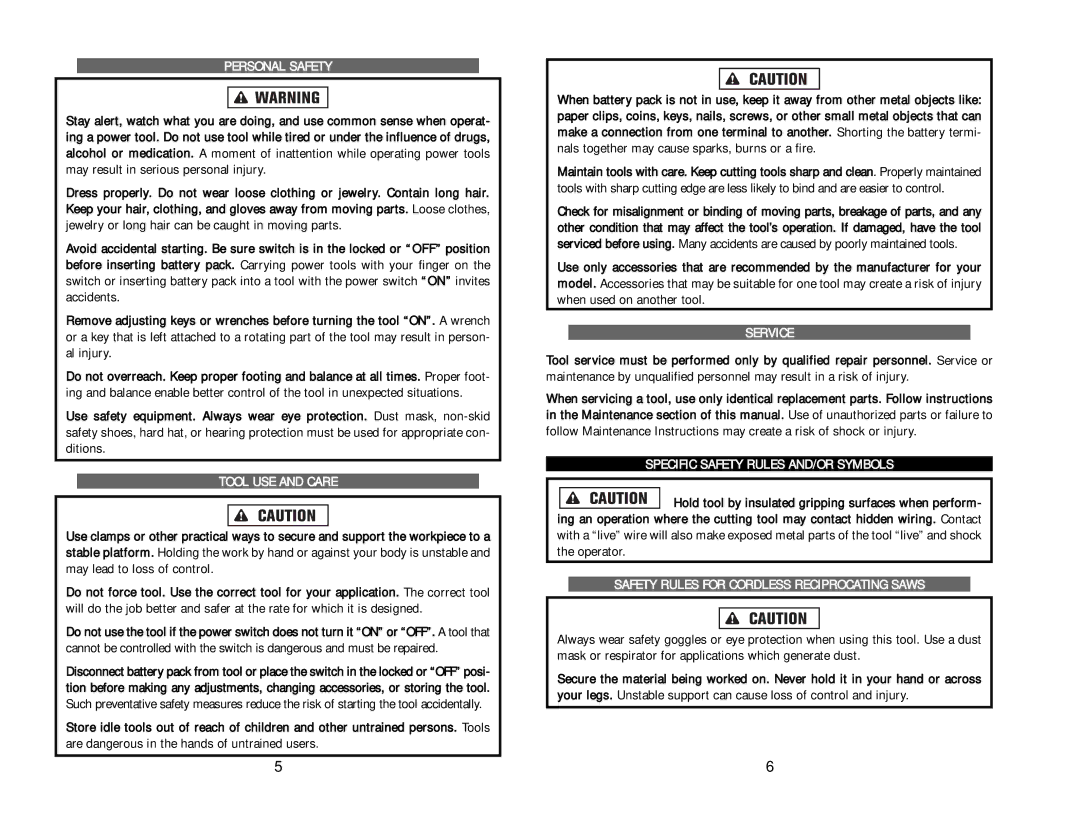
PERSONAL SAFETY
Stay alert, watch what you are doing, and use common sense when operat- ing a power tool. Do not use tool while tired or under the influence of drugs, alcohol or medication. A moment of inattention while operating power tools may result in serious personal injury.
Dress properly. Do not wear loose clothing or jewelry. Contain long hair. Keep your hair, clothing, and gloves away from moving parts. Loose clothes, jewelry or long hair can be caught in moving parts.
Avoid accidental starting. Be sure switch is in the locked or “OFF” position before inserting battery pack. Carrying power tools with your finger on the switch or inserting battery pack into a tool with the power switch “ON” invites accidents.
Remove adjusting keys or wrenches before turning the tool “ON”. A wrench or a key that is left attached to a rotating part of the tool may result in person- al injury.
Do not overreach. Keep proper footing and balance at all times. Proper foot- ing and balance enable better control of the tool in unexpected situations.
Use safety equipment. Always wear eye protection. Dust mask,
TOOL USE AND CARE
Use clamps or other practical ways to secure and support the workpiece to a stable platform. Holding the work by hand or against your body is unstable and may lead to loss of control.
Do not force tool. Use the correct tool for your application. The correct tool will do the job better and safer at the rate for which it is designed.
Do not use the tool if the power switch does not turn it “ON” or “OFF”. A tool that cannot be controlled with the switch is dangerous and must be repaired.
Disconnect battery pack from tool or place the switch in the locked or “OFF” posi- tion before making any adjustments, changing accessories, or storing the tool. Such preventative safety measures reduce the risk of starting the tool accidentally.
Store idle tools out of reach of children and other untrained persons. Tools are dangerous in the hands of untrained users.
When battery pack is not in use, keep it away from other metal objects like: paper clips, coins, keys, nails, screws, or other small metal objects that can make a connection from one terminal to another. Shorting the battery termi- nals together may cause sparks, burns or a fire.
Maintain tools with care. Keep cutting tools sharp and clean. Properly maintained tools with sharp cutting edge are less likely to bind and are easier to control.
Check for misalignment or binding of moving parts, breakage of parts, and any other condition that may affect the tool’s operation. If damaged, have the tool serviced before using. Many accidents are caused by poorly maintained tools.
Use only accessories that are recommended by the manufacturer for your model. Accessories that may be suitable for one tool may create a risk of injury when used on another tool.
SERVICE
Tool service must be performed only by qualified repair personnel. Service or maintenance by unqualified personnel may result in a risk of injury.
When servicing a tool, use only identical replacement parts. Follow instructions in the Maintenance section of this manual. Use of unauthorized parts or failure to follow Maintenance Instructions may create a risk of shock or injury..
SPECIFIC SAFETY RULES AND/OR SYMBOLS
![]()
![]()
![]()
![]()
![]()
![]()
![]() Hold tool by insulated gripping surfaces when perform- ing an operation where the cutting tool may contact hidden wiring. Contact with a “live” wire will also make exposed metal parts of the tool “live” and shock the operator.
Hold tool by insulated gripping surfaces when perform- ing an operation where the cutting tool may contact hidden wiring. Contact with a “live” wire will also make exposed metal parts of the tool “live” and shock the operator.
SAFETY RULES FOR CORDLESS RECIPROCATING SAWS
Always wear safety goggles or eye protection when using this tool. Use a dust mask or respirator for applications which generate dust.
Secure the material being worked on. Never hold it in your hand or across your legs. Unstable support can cause loss of control and injury.
5 | 6 |
